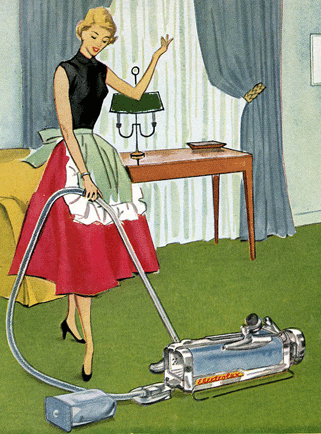|
Thread Number: 15945
Classic Hoover Wands |
[Down to Last] |  |
| Post# 170023 2/18/2012 at 18:09 (4,449 days old) by eurekaprince (Montreal, Canada) | ||

Here's a question that has kind of mystified me for many years.
Being the Eureka fanatic that I am, I had very little exposure to the details of Hoover cleaners before adulthood (pre-1980) at which point I had more "courage and cash" to play with more vacs. Before 1980, whenever I had the rare opportunity to actually clean/play with a Hoover (cleaning up after a party at someone else's home, for example), I would notice the main differences between Eureka vacs and Hoover vacs. One of the differences that always stood out for me was that Eureka wands were always inserted INTO the neck of the Eureka attachments, while Hoover wands were always slid OVER the neck of the Hoover attachments. Also, Eureka attachments and wands were friction-fit, whereas Hoover's hose handle and wands had a clip to securely attach the tools. Though Eureka friction fit attachments allowed you to position the tool in any angle you wanted (sideways or upside-down, for example), the Hoover connection system forced the tool to stay in one designated position. But, at some point, I realized that Hoover provided a neat feature that made their system quite good for suction, if I remember correctly: there was an internal rubber gasket that created a suction seal inside the hose handle or the wand whenever another piece was attached. My question: Am I remembering correctly? Did Hoover hose handles and wands have such an internal rubber gasket? And if yes, did this actually work? Did it actually create a good suction seal? Did these rubber gaskets ever cause problems? Did they ever deteriorate or break off? When did Hoover start using this air-seal system? And when did the system stop appearing on Hoover cleaners? Was the system provided on European Hoovers as well (before Candy bought Hoover Europe)? This Eurekaprince is curious to know! :-) | ||
| Post# 170033 , Reply# 2 2/18/2012 at 18:52 (4,449 days old) by eurekaprince (Montreal, Canada) | ||

Thanks for that comprehensive response, Benny. Interesting to hear that even with the clips and "suction seal" gaskets, the Hoover tubes and attachments sometimes felt wobbly. I wonder if the rubber gasket eventually lost it's "sealing ability" due to wear and tear and dirt and dust.....
Wish I knew why we in North America have always referred to vacuum tubes as "wands"! It sounds so magical, and yet it is so weird that this word is used for nothing else but vacuum tubes and magician sticks! :-D | ||
| Post# 170037 , Reply# 4 2/18/2012 at 19:24 (4,449 days old) by kenkart () | ||
|
Hoover Wands.. It has been my experience that as they age they do get sloppy, Eureka wands stay tight forever, Also the early aluminum GE wands are terribly prone to wear out .Where as Airway aluminum wands never wear out??? | ||
| Post# 170039 , Reply# 5 2/18/2012 at 19:32 (4,449 days old) by eurekaprince (Montreal, Canada) | ||

The friction fit aluminum tubes we had for our old General Electric AVT brown cylinder vac merged so tightly that at one point, we could not even separate them - so they remained locked together forever!
The vac-makers providing friction-fit wands should really have added rubber handgrips on each end of the tube so that these would be easy to separate if they ever got too tight. | ||
| Post# 170217 , Reply# 6 2/20/2012 at 11:28 (4,447 days old) by vacbear58 (Sutton In Ashfield & London) | ||
A bit more in the UK
From my recollection of things Hoover always had some sort of locking system up until the late 1940s. On the 160/262 and possibly 612 it was possible to swivel the connection. Then it gets a bit complicated. Friction fit tools were first seen on the 402 cannister (1947) and 119 upright. In the case of the 119 the tools look similar to those on the earlier 375 which did have lock fitting. The pip and clip arrangement was first seen on the model 417 (1953) although on this model they are on the underside rather than the top. The 417 also had the Aerodyne style rug nozzle.
When the Connie 822 (1956) was launched the 417 was downgraded in several respects (417C/417E) including a reversion to friction fit tools with a rug nozzle back to the earlier 402 style. Friction fit was retained until 1962 (or so) when the 417E was revised to the 417G. The loopy thing was that all other Hoover cleaners from 1956 onwards (ok maybe 1957 for the 1224) all used pip and clip - even the dustette tools! So either they had a heck of a lot of old stock parts or they did not pay acttention to their cost accountants (and before you start, thats my background, so dont start!) for it was crazy to run inventory for all the variety of nozzles that this required. I personally do not care much for the plastic twist lock tools, although again some of the TOL cannisters had these in chrome, and curiously at the same time as some US equivalent models were still using traditional pip and clip. The first model I know of to have friction fit again was the late 1980s Galaxy model, followed by the uprights with on board tools. Al | ||

 Comes to the Rescue!
Comes to the Rescue!